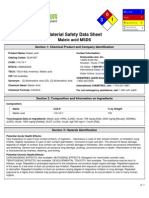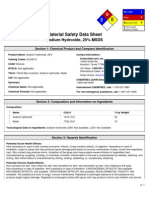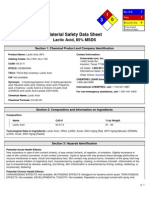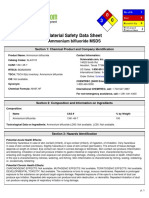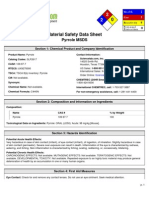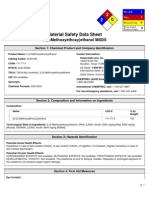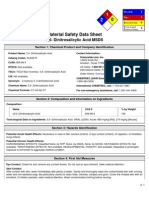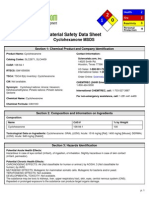Acetic Anhydride MSDS: Section 1: Chemical Product and Company Identification
Acetic Anhydride MSDS: Section 1: Chemical Product and Company Identification
Uploaded by
Adri MuntahaCopyright:
Available Formats
Acetic Anhydride MSDS: Section 1: Chemical Product and Company Identification
Acetic Anhydride MSDS: Section 1: Chemical Product and Company Identification
Uploaded by
Adri MuntahaOriginal Title
Copyright
Available Formats
Share this document
Did you find this document useful?
Is this content inappropriate?
Copyright:
Available Formats
Acetic Anhydride MSDS: Section 1: Chemical Product and Company Identification
Acetic Anhydride MSDS: Section 1: Chemical Product and Company Identification
Uploaded by
Adri MuntahaCopyright:
Available Formats
2 3
Material Safety Data Sheet
Acetic anhydride MSDS
Section 1: Chemical Product and Company Identification
Product Name: Acetic anhydride Catalog Codes: SLA1693 CAS#: 108-24-7 RTECS: AK1925000 TSCA: TSCA 8(b) inventory: Acetic anhydride CI#: Not available. Synonym: Chemical Formula: (CH3CO)2) Contact Information: Sciencelab.com, Inc. 14025 Smith Rd. Houston, Texas 77396 US Sales: 1-800-901-7247 International Sales: 1-281-441-4400 Order Online: ScienceLab.com
He a lt h
3 2 0
Fire Re a c t iv it y P e rs o n a l P ro t e c t io n
CHEMTREC (24HR Emergency Telephone), call: 1-800-424-9300 International CHEMTREC, call: 1-703-527-3887 For non-emergency assistance, call: 1-281-441-4400
Section 2: Composition and Information on Ingredients
Composition: Name Acetic anhydride CAS # 108-24-7 % by Weight 100
Toxicological Data on Ingredients: Acetic anhydride: ORAL (LD50): Acute: 1780 mg/kg [Rat]. DERMAL (LD50): Acute: 4000 mg/kg [Rabbit].
Section 3: Hazards Identification
Potential Acute Health Effects: Extremely hazardous in case of skin contact (irritant), of eye contact (irritant), of ingestion, of inhalation. Very hazardous in case of skin contact (corrosive). Hazardous in case of skin contact (permeator). Liquid or spray mist may produce tissue damage particularly on mucous membranes of eyes, mouth and respiratory tract. Skin contact may produce burns. Inhalation of the spray mist may produce severe irritation of respiratory tract, characterized by coughing, choking, or shortness of breath. Inflammation of the eye is characterized by redness, watering, and itching. Skin inflammation is characterized by itching, scaling, reddening, or, occasionally, blistering. Potential Chronic Health Effects: CARCINOGENIC EFFECTS: Not available. MUTAGENIC EFFECTS: Not available. TERATOGENIC EFFECTS: Not available. DEVELOPMENTAL TOXICITY: Not available. The substance is toxic to lungs, mucous membranes. Repeated or prolonged exposure to the substance can produce target organs damage. Repeated or prolonged contact with spray mist may produce chronic eye irritation and severe skin irritation. Repeated or prolonged exposure to spray mist may produce respiratory tract irritation leading to frequent attacks of bronchial infection.
p. 1
Section 4: First Aid Measures
Eye Contact: Check for and remove any contact lenses. In case of contact, immediately flush eyes with plenty of water for at least 15 minutes. Get medical attention immediately. Skin Contact: In case of contact, immediately flush skin with plenty of water for at least 15 minutes while removing contaminated clothing and shoes. Cover the irritated skin with an emollient. Wash clothing before reuse. Thoroughly clean shoes before reuse. Get medical attention immediately. Serious Skin Contact: Wash with a disinfectant soap and cover the contaminated skin with an anti-bacterial cream. Seek immediate medical attention. Inhalation: If inhaled, remove to fresh air. If not breathing, give artificial respiration. If breathing is difficult, give oxygen. Get medical attention immediately. Serious Inhalation: Evacuate the victim to a safe area as soon as possible. Loosen tight clothing such as a collar, tie, belt or waistband. If breathing is difficult, administer oxygen. If the victim is not breathing, perform mouth-to-mouth resuscitation. WARNING: It may be hazardous to the person providing aid to give mouth-to-mouth resuscitation when the inhaled material is toxic, infectious or corrosive. Seek immediate medical attention. Ingestion: Do NOT induce vomiting unless directed to do so by medical personnel. Never give anything by mouth to an unconscious person. If large quantities of this material are swallowed, call a physician immediately. Loosen tight clothing such as a collar, tie, belt or waistband. Serious Ingestion: Not available.
Section 5: Fire and Explosion Data
Flammability of the Product: Flammable. Auto-Ignition Temperature: 316C (600.8F) Flash Points: CLOSED CUP: 49C (120.2F). OPEN CUP: 51C (123.8F). Flammable Limits: LOWER: 2.7% UPPER: 10.3% Products of Combustion: These products are carbon oxides (CO, CO2). Fire Hazards in Presence of Various Substances: Flammable in presence of heat. Explosion Hazards in Presence of Various Substances: Risks of explosion of the product in presence of mechanical impact: Not available. Risks of explosion of the product in presence of static discharge: Not available. Fire Fighting Media and Instructions: Flammable liquid. SMALL FIRE: Use DRY chemical powder. LARGE FIRE: Use alcohol foam, water spray or fog. Cool containing vessels with water jet in order to prevent pressure build-up, autoignition or explosion. Special Remarks on Fire Hazards: Not available. Special Remarks on Explosion Hazards: Not available.
Section 6: Accidental Release Measures
Small Spill: Absorb with an inert material and put the spilled material in an appropriate waste disposal. p. 2
Large Spill: Flammable liquid. Corrosive liquid. Keep away from heat. Keep away from sources of ignition. Stop leak if without risk. Absorb with DRY earth, sand or other non-combustible material. Do not get water inside container. Do not touch spilled material. Use water spray curtain to divert vapor drift. Prevent entry into sewers, basements or confined areas; dike if needed. Call for assistance on disposal. Be careful that the product is not present at a concentration level above TLV. Check TLV on the MSDS and with local authorities.
Section 7: Handling and Storage
Precautions: Keep container dry. Keep away from heat. Keep away from sources of ignition. Ground all equipment containing material. Do not ingest. Do not breathe gas/fumes/ vapor/spray. Never add water to this product. In case of insufficient ventilation, wear suitable respiratory equipment. If ingested, seek medical advice immediately and show the container or the label. Avoid contact with skin and eyes. Storage: Store in a segregated and approved area. Keep container in a cool, well-ventilated area. Keep container tightly closed and sealed until ready for use. Avoid all possible sources of ignition (spark or flame).
Section 8: Exposure Controls/Personal Protection
Engineering Controls: Provide exhaust ventilation or other engineering controls to keep the airborne concentrations of vapors below their respective threshold limit value. Ensure that eyewash stations and safety showers are proximal to the work-station location. Personal Protection: Face shield. Full suit. Vapor respirator. Be sure to use an approved/certified respirator or equivalent. Gloves. Boots. Personal Protection in Case of a Large Spill: Splash goggles. Full suit. Vapor respirator. Boots. Gloves. A self contained breathing apparatus should be used to avoid inhalation of the product. Suggested protective clothing might not be sufficient; consult a specialist BEFORE handling this product. Exposure Limits: TWA: 5 TWA: 20 Consult local authorities for acceptable exposure limits.
Section 9: Physical and Chemical Properties
Physical state and appearance: Liquid. Odor: Strong. Taste: Strong. Molecular Weight: 102.09 g/mole Color: Light. pH (1% soln/water): Not available. Boiling Point: 139.9C (283.8F) Melting Point: -73.1 (-99.6F) Critical Temperature: Not available. Specific Gravity: 1.08 (Water = 1) Vapor Pressure: 0.5 kPa (@ 20C) Vapor Density: 3.52 (Air = 1) p. 3
Volatility: Not available. Odor Threshold: 0.1 ppm Water/Oil Dist. Coeff.: Not available. Ionicity (in Water): Not available. Dispersion Properties: Not available. Solubility: Not available.
Section 10: Stability and Reactivity Data
Stability: The product is stable. Instability Temperature: Not available. Conditions of Instability: Not available. Incompatibility with various substances: Not available. Corrosivity: Not available. Special Remarks on Reactivity: Not available. Special Remarks on Corrosivity: Not available. Polymerization: Will not occur.
Section 11: Toxicological Information
Routes of Entry: Dermal contact. Eye contact. Inhalation. Ingestion. Toxicity to Animals: WARNING: THE LC50 VALUES HEREUNDER ARE ESTIMATED ON THE BASIS OF A 4-HOUR EXPOSURE. Acute oral toxicity (LD50): 1780 mg/kg [Rat]. Acute dermal toxicity (LD50): 4000 mg/kg [Rabbit]. Acute toxicity of the vapor (LC50): 1000 4 hours [Rat]. Chronic Effects on Humans: Causes damage to the following organs: lungs, mucous membranes. Other Toxic Effects on Humans: Extremely hazardous in case of skin contact (irritant), of ingestion, . Very hazardous in case of skin contact (corrosive). Hazardous in case of skin contact (permeator), of eye contact (corrosive), of inhalation (lung corrosive). Special Remarks on Toxicity to Animals: Not available. Special Remarks on Chronic Effects on Humans: Not available. Special Remarks on other Toxic Effects on Humans: Not available.
Section 12: Ecological Information
Ecotoxicity: Not available. BOD5 and COD: Not available. Products of Biodegradation: Possibly hazardous short term degradation products are not likely. However, long term degradation products may arise. Toxicity of the Products of Biodegradation: The products of degradation are less toxic than the product itself. Special Remarks on the Products of Biodegradation: Not available.
p. 4
Section 13: Disposal Considerations
Waste Disposal:
Section 14: Transport Information
DOT Classification: Class 8: Corrosive material Identification: : Acetic Anhydride UNNA: UN1715 PG: II Special Provisions for Transport: Not available.
Section 15: Other Regulatory Information
Federal and State Regulations: Pennsylvania RTK: Acetic anhydride Massachusetts RTK: Acetic anhydride TSCA 8(b) inventory: Acetic anhydride CERCLA: Hazardous substances.: Acetic anhydride Other Regulations: OSHA: Hazardous by definition of Hazard Communication Standard (29 CFR 1910.1200). Other Classifications: WHMIS (Canada): CLASS B-3: Combustible liquid with a flash point between 37.8C (100F) and 93.3C (200F). CLASS E: Corrosive liquid. DSCL (EEC): R10- Flammable. R20/22- Harmful by inhalation and if swallowed. R34- Causes burns. HMIS (U.S.A.): Health Hazard: 3 Fire Hazard: 2 Reactivity: 0 Personal Protection: National Fire Protection Association (U.S.A.): Health: 3 Flammability: 2 Reactivity: 1 Specific hazard: Protective Equipment: Gloves. Full suit. Vapor respirator. Be sure to use an approved/certified respirator or equivalent. Wear appropriate respirator when ventilation is inadequate. Face shield.
Section 16: Other Information
References: Not available. Other Special Considerations: Not available. Created: 10/10/2005 08:13 PM Last Updated: 11/01/2010 12:00 PM The information above is believed to be accurate and represents the best information currently available to us. However, we make no warranty of merchantability or any other warranty, express or implied, with respect to such information, and we assume p. 5
no liability resulting from its use. Users should make their own investigations to determine the suitability of the information for their particular purposes. In no event shall ScienceLab.com be liable for any claims, losses, or damages of any third party or for lost profits or any special, indirect, incidental, consequential or exemplary damages, howsoever arising, even if ScienceLab.com has been advised of the possibility of such damages.
p. 6
You might also like
- Msds Ac2oDocument6 pagesMsds Ac2oArfin FardiansyahNo ratings yet
- Msds Acetyl ChlorideDocument6 pagesMsds Acetyl ChlorideghungrudswapnilNo ratings yet
- Msds C7H5OClDocument6 pagesMsds C7H5OClwindawardhaniNo ratings yet
- MSDSDocument6 pagesMSDSAra HilisNo ratings yet
- Anhidrida Asetat Msds PDFDocument6 pagesAnhidrida Asetat Msds PDFFistia MaulinaNo ratings yet
- Sulfanilamide MSDS: Section 1: Chemical Product and Company IdentificationDocument6 pagesSulfanilamide MSDS: Section 1: Chemical Product and Company IdentificationIsti YaniNo ratings yet
- Ferricchloride MsdsDocument5 pagesFerricchloride MsdsTicha MaharaniNo ratings yet
- BenzinDocument6 pagesBenzinmicaziv4786No ratings yet
- CikloheksilaminDocument6 pagesCikloheksilaminmicaziv4786No ratings yet
- Msds BUTIRALDocument6 pagesMsds BUTIRALSatrio Rekso Hadi PNo ratings yet
- Maleic Anhydride MSDS: Section 1: Chemical Product and Company IdentificationDocument6 pagesMaleic Anhydride MSDS: Section 1: Chemical Product and Company IdentificationFábio BrancoNo ratings yet
- MSDSPJDocument6 pagesMSDSPJapi-263411629No ratings yet
- Material Safety Data SheetDocument6 pagesMaterial Safety Data Sheetonna25No ratings yet
- Ammonium Fluoride 40% MSDS: Section 1: Chemical Product and Company IdentificationDocument6 pagesAmmonium Fluoride 40% MSDS: Section 1: Chemical Product and Company IdentificationAndika PermanaNo ratings yet
- MsdsDocument6 pagesMsdsSamsuri SamrezNo ratings yet
- MsdsDocument5 pagesMsdsAnonymous ZTkfDqNo ratings yet
- MSDS of Sodium DichromateDocument6 pagesMSDS of Sodium DichromateJackiee1983No ratings yet
- MsdsDocument6 pagesMsdsRoby SuheriNo ratings yet
- Msds of GlycidolDocument6 pagesMsds of GlycidolDinesh TanwarNo ratings yet
- Acetophenon PDFDocument6 pagesAcetophenon PDFYuris Yurdiansah Munandar0% (1)
- Acetophenone PDFDocument6 pagesAcetophenone PDFYuliana Ja'farNo ratings yet
- KCLO3Document6 pagesKCLO3Raditya Rizki AmaliaNo ratings yet
- Car Boxy Benz Alde HideDocument5 pagesCar Boxy Benz Alde HideReksy WibowoNo ratings yet
- Msds Cyanide ChlorideDocument6 pagesMsds Cyanide ChlorideKhoai Sai GonNo ratings yet
- 1 1 - Dichloroethane MSDSDocument6 pages1 1 - Dichloroethane MSDSAndi Tri SaputraNo ratings yet
- (ch3) 2so4Document6 pages(ch3) 2so4arbol100100% (1)
- Msds Diaseton AlkoholDocument5 pagesMsds Diaseton AlkoholtakenoveraccountNo ratings yet
- Ethyl ChlorideDocument5 pagesEthyl ChlorideAprilia SusantiNo ratings yet
- Naphthalene MSDS: Section 1: Chemical Product and Company IdentificationDocument6 pagesNaphthalene MSDS: Section 1: Chemical Product and Company IdentificationAdalberto AlvarezNo ratings yet
- MSDS - Isoamil AlkoholDocument6 pagesMSDS - Isoamil AlkoholAyu MurtiNo ratings yet
- Lactic Acid MsdsDocument6 pagesLactic Acid MsdsBlue Ofo-ob TJNo ratings yet
- Cinna Mal de HideDocument5 pagesCinna Mal de Hiderully1234No ratings yet
- Titanium Tetrachloride MSDS: Section 1: Chemical Product and Company IdentificationDocument5 pagesTitanium Tetrachloride MSDS: Section 1: Chemical Product and Company IdentificationSurya AlchemiztNo ratings yet
- Msds Ammonium Bifluoride PDFDocument5 pagesMsds Ammonium Bifluoride PDFDesiyantri Siti PinundiNo ratings yet
- Msds Dietilamina PDFDocument6 pagesMsds Dietilamina PDFabi9f100% (1)
- Urea MsdsDocument5 pagesUrea MsdsRea Candra OktaviaraNo ratings yet
- Anhidrida Asetat MsdsDocument6 pagesAnhidrida Asetat MsdsmentaridaNo ratings yet
- Sodium Chromate Anhydrous PDFDocument6 pagesSodium Chromate Anhydrous PDFErika WidiariniNo ratings yet
- Pyrolle MsdsDocument5 pagesPyrolle MsdsAmalina HazwaniNo ratings yet
- MsdsDocument6 pagesMsdsRizki Adwitiyo 'Dito'No ratings yet
- Sodium Ethoxide MSDS: Section 1: Chemical Product and Company IdentificationDocument6 pagesSodium Ethoxide MSDS: Section 1: Chemical Product and Company IdentificationJosé Martín Meza CabillasNo ratings yet
- Msds ThioacetamideDocument6 pagesMsds ThioacetamideOscar Aviles0% (1)
- Bu-Li MSDSDocument6 pagesBu-Li MSDSPrakash VenkatesanNo ratings yet
- EthanolDocument5 pagesEthanolGery Job'sNo ratings yet
- 14.kalium DikromatDocument6 pages14.kalium DikromatDarla PowersNo ratings yet
- MsdsDocument6 pagesMsdsWind AzCaNo ratings yet
- Msds DNSADocument5 pagesMsds DNSAfontianikaNo ratings yet
- MSDS Comassie BlueDocument5 pagesMSDS Comassie BlueExma Mu'tatal HikmahNo ratings yet
- CikloheksanonDocument7 pagesCikloheksanonmicaziv4786No ratings yet
- Sodium Chromate TetrahydrateDocument6 pagesSodium Chromate TetrahydrateErika WidiariniNo ratings yet
- Msds Isopropil EterDocument5 pagesMsds Isopropil EterLidwina Margaretha LakaNo ratings yet
- Ferric ChlorideDocument5 pagesFerric ChlorideRivaldi Di CaprioNo ratings yet
- Georgia Pest Management Handbook: 2021 Home and Garden EditionFrom EverandGeorgia Pest Management Handbook: 2021 Home and Garden EditionEmily CabreraNo ratings yet
- After a Disaster - Information to Help You and Your Family RecoverFrom EverandAfter a Disaster - Information to Help You and Your Family RecoverNo ratings yet
- Survival Skills: How to Survive Anything and Anywhere in the World (A Comprehensive Guide to Preparing for and Overcoming Challenges of Earthquakes)From EverandSurvival Skills: How to Survive Anything and Anywhere in the World (A Comprehensive Guide to Preparing for and Overcoming Challenges of Earthquakes)No ratings yet
- First Aid on the Farm: Natural and Conventional TreatmentsFrom EverandFirst Aid on the Farm: Natural and Conventional TreatmentsNo ratings yet












